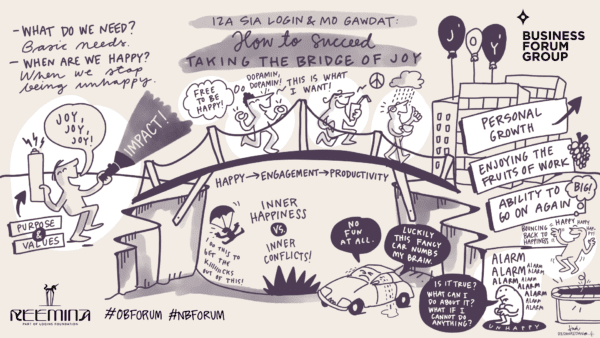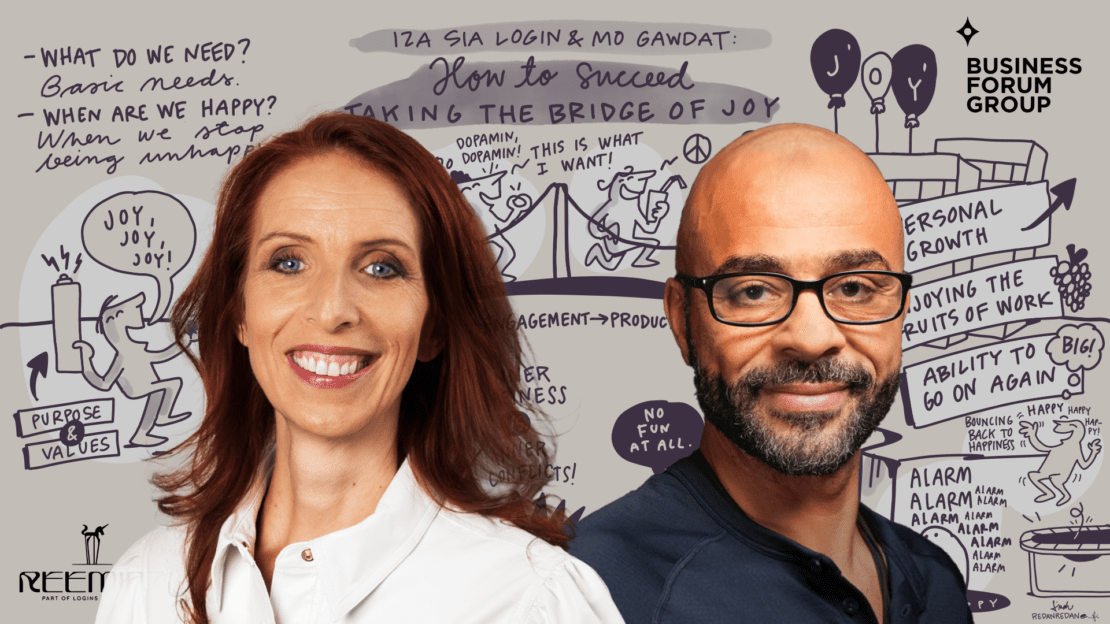9Jun2022
At our webinar on the 8th of June, Iza Sia Login, CEO of Reemina Academy and co-founder of the tech unicorn Outfit7, and Mo Gawdat, former Chief Business Officer at GoogleX, explained how raising joy across the entire company is the fastest and most rewarding way to extraordinary success and why it is the largest untapped opportunity for leaders.
If you missed the session or want to go back to it, you can tune in for the recording here:
The Secret Ingredient in a Success Formula
Iza kicked off by admitting that, “with 18 billion downloads, and more than 70 billion media views, purpose and values played a major role in our success, but there was one element that we found that contributed a lot and it was joy”. In fact, she recalled when they built an app on a tight schedule and made a great effort to meet the deadline. “The app was not successful and when we researched what went wrong, we found out that people did not enjoy building it”, she said.
The Flashlight Model
If joy is key for success, how can a leader notice when this ingredient is missing in an organization? Iza’s answer to this question was the “flashlight leadership model” which consists of five parts: battery, which represents purpose and values; the bulb, which stands for the leader; the lens, for the team; the casing which represents the agreements, rules, and processes of how people work together. And last, but not least, is the beam. “The longer the beam, the greater the success”, Iza stated.
Having a properly set flashlight is the starting point. However, as companies work towards their goal, they come across challenges, conflicts, even technical and cash flow issues, which deplete people’s energy. “When the objective is reached, people are tired, with no energy to commit to another project. A more effective way to go from the beginning to the goal is to build a bridge of joy, to set processes that help people work joyfully in every situation”, Iza added.
Creating a Bridge of Joy
The vibe in which people work makes a huge difference in the outcome. This vibe is impossible to fake and cannot be bought, so, how can leaders raise joy across the entire company? Iza shared some tips. One of them is: “if you don’t feel joy, if you have an inner conflict, or are in a conflict with someone else, take some time off”. It could be ten minutes, an hour, even a day. Some people, like Iza, go out into nature or take a 20-minute meditation and try to feel centered before coming back to work.
Another example are the “smoothie meetings” where people gather to smooth things out. “They come with smoothies, so it is a pleasant situation, and they not only discuss difficult issues but also talk about how they can help each other achieve their goals. This initiative lifts up the spirits and vibe of the team”, concluded Iza.
The Happiness Equation
Mo took Iza’s baton and asked: “how can we build the casing of the flashlight? How can we run a business where people are encouraged to be happy?” And immediately he answered: the trick is to realize that no company can make anyone happy. What a company can do is to create a place where people can choose to be happy and remove the reasons that can make people unhappy.
The core of Mo’s idea is that happiness is a personal choice and to explain it further he laid out three assumptions:
- Happiness doesn’t come from the outside. It is our default and inner state.
- Happiness is the absence of unhappiness. This assumption is more evident in children who are naturally happy and become unhappy when something goes wrong, when there is a reason. “If a diaper feels wet, the child will cry until the mother changes the diaper”, added Mo.
- It is not the events in your life that make you unhappy, it’s the events in your life as compared with how you want life to be. In order to explain this better, he gave the example of rain which makes you happy if you want to water your plants and it makes you unhappy if you want to sit in the sun.
How to Remove Unhappiness
According to Mo, happiness is a moment when events meet or exceed expectations. “It is a calm and peaceful contentment that you feel in your heart when you feel okay with life as it is. It doesn’t matter what life is”, he added.
On the other hand, when events miss expectations, the brain triggers an emotion like sadness, fear or anxiety. Mo explained that these emotions are a survival mechanism, like an alarm telling you that something is wrong. But instead of acting upon it, we tend to exaggerate the situation. “We have the ability to create unhappiness on demand. If your girlfriend says she doesn’t love you anymore, the next day you think you will spend the rest of your life alone.”
Mo’s recommendation to achieve happiness is to react to our survival mechanism as we would react to a fire alarm: we go out and ask three questions:
- Is it true? If the answer is no, drop it. If it is true, then ask yourself:
- What can you do about it? The moment you start doing something, you stop being unhappy.
- Finally, if you can’t do anything about it, accept the situation.
Words for leaders
In the last part of his presentation, Mo explained that the ground rule for building a company environment that makes people happy is to have 100% transparency so that everyone can see the events exactly for what they are.
And, when things go wrong, he advised leaders to use the three question framework: Is it true that the product is not going to succeed? If it is, how can we make it better? If we cannot fix it, how do we let it go and start to build something new?

Visual summary by Linda Saukko-Rauta


